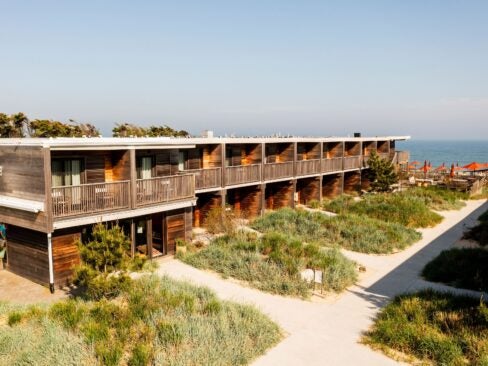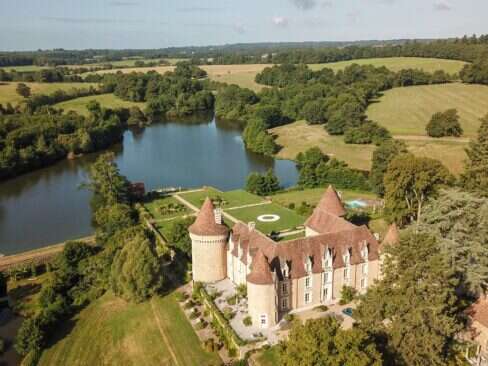
Since the days of the Aztecs and Mayans, Mexico has served as a very welcoming canvas for innovative design and architecture.
By harnessing the inspiration and soul of the country itself, modern designers not only add gleaming skyscrapers to city skylines and gorgeous hotels to coastal beaches; they also follow in a tradition that celebrates the spirit of Mexico while leaving yet another series of stunning landmarks on the country’s face and adding another chapter to its glorious design history.
Architecture and Design in Mexico

Luis Barragán, arguably Mexico’s most important modern architect (he designed Mexico City’s impressive Torres de Satélite buildings among many others), once said, “The lessons to be learned from the unassuming architecture of the village and provincial towns of my country have been a permanent source of inspiration.”
In keeping with those sentiments, Mexico has inspired bold, progressive designers and architects, both homegrown talent like Barragán, Juan José Díaz Infante Núñez (who designed the striking Mexico Stock Exchange) and Ricardo Legoretta (architect of Mexico City’s stunning Camino Real Hotel) as well as international luminaries like Norman Foster, whose firm Foster + Partners is embarking on Mexico’s newest addition to the cutting-edge design world. No stranger to important projects (the firm designed the Beijing Airport, the largest single building on the planet), the company is working on the massive Campus Biometropolis project in southern Mexico City.
The 71-hectare masterplan will be a center for stateof- the-art medical facilities, laboratories and teaching and research institutions. An all-new on-site nature reserve will aim to protect the surrounding populations of indigenous plants and animals as well. In addition to impressive landscaped zones and cutting-edge hotel facilities for visitors to the campus’ medical and conference facilities, the project will incorporate public piazzas, courtyards and pedestrian streets, ensuring that this mixed-use project fits right into the urban setting of Mexico City and contributes to the neighborhood’s vitality and authenticity.
The development will be as sustainable as it is slick: All buildings will be oriented toward the North to capture winds for builtin cooling, and the buildings have been designed to capture rainwater as a potential solution to Mexico City’s water shortages.
Nigel Dancey, a senior partner and design director at Foster + Partners, points out that drawing inspiration from the community and from Mexico itself created the impetus to return something to the community, too: “Campus Biometropolis is our first masterplan in Mexico. It is the first of its kind—a unique opportunity to create a medical district of international importance. The masterplan will incorporate state-of-the-art facilities and buildings with a wide range of functions. The project will help safeguard the recharging of the aquifer supplying much of Mexico City and protect indigenous plant and animal species, as well as the important geological formations found on the site.”
Architecture and Design in Mexico

“The lessons to be learned from the unassuming architecture of the village and provincial towns of my country have been a permanent source of inspiration.” —Luis Barragán, renowned architect
In keeping with those sentiments, Mexico has inspired bold, progressive designers and architects, both homegrown talent like Barragán, Juan José Díaz Infante Núñez and Ricardo Legoretta, in addition to international luminaries like Norman Foster of Foster + Partners.
That same spirit of inspiration, innovation and sustainability is reflected in the new breed of luxury hotels opening all across Mexico. Fans of fine design should book a stay in one of these striking hotels, all of which boast an ultra-modern feel and luxury accommodations to match:
One of Cabo’s most buzzworthy new properties is Capella Pedregal. With architecture by HKS, Inc., interiors by Paul Duesing Partners and landscaping by Charles S. McDaniel of The SWA Group, Capella Pedregal was brought to fruition by the same team who created the ultra-luxe accommodations at nearby Las Ventanas al Paraiso. This stunning resort community was inspired by, and easily equals, the dramatic beauty of the Cabo landscape. The property’s first impression is perhaps its most lasting one: Visitors are blown away by the 1,000-foot-long tunnel, carved through the heart of the mountain to provide guests entry into Capella Pedregal’s courtyard. (www.capellapedregal.com).
Designed by renowned Mexican architect Miguel Angel Aragones, the debut of Hotel Encanto marks a return to glamour in Acapulco. Aragones’ trendsetting design pays homage to the sea, with private terraces in all 44 suites overlooking the ocean. The structural design incorporates two concrete back walls with open facades to afford unobstructed views of the ocean from virtually anywhere on the property. (www.hotelencanto.com.mx).
Likewise, the St. Regis Mexico City is more than just a hotel—it’s an impressive new architectural landmark in the historic heart of Mexico’s capital. Cesar Pelli of Pelli Clarke Pelli, the acclaimed architect behind such structures as the Petronas Towers in Kuala Lumpur and New York’s World Financial Center, created this 495-foot-high property to be both physically commanding and culturally significant. Once inside, the interiors are every bit as arresting: Design firm Yabu Pushelberg has used custom metal and leather detailing, specially-designed furnishings and rich colors to create a one-of-a-kind look and feel. (www.stregis.com/mexicocity).
Also designed by Yabu Pushelberg, Mexico City’s latest boutique property, Las Alcobas, offers 35 guestrooms— ranging in square footage from 400 to 1,600—over seven stylish stories. You’ll feel right at home in the inviting yet thoroughly modern interiors, which blend Yabu Pushelberg’s custom-built rosewood furniture, leather wall panels, original works from contemporary Mexican artists and the true pièce de résistance: An impressive spiral staircase that makes for a dramatic centerpiece in the hotel lobby. (www.lasalcobas.com).
With unique architecture, courtesy of Banyan Tree’s inhouse Architrave Design and Planning arm, the new Banyan Tree Cabo Marqués in Acapulco was influenced by the city’s strong historical ties to Asia as a major port of call for China in the 1800s. The exclusive design includes bold Far East-inspired touches like pitched roofs and wide eaves. Tying back to the Asian theme, all villas are elevated on stilts, but authentically Mexican elements like Talavera ceramics, indigenous sculptures and artworks and traditional fabric from Chiapas bring a taste of the local traditions back to the resort. (www.banyantree.com/cabomarques).
Explore Mexico’s elite structures or book your next stylish stay by checking out www.visitmexico.com to learn more.
Elite Real Estate Design

Chicago-based design firm Soucie Horner, Ltd. created an idyllic hideaway for one very lucky American couple.
This 2,200-square-foot Puerto Vallarta property (pictured at left) once belonged to a Mexican government official, and now— thanks to a full architectural renovation and interior decorating by the talented team—it’s a dream vacation home that can be enjoyed year-round. Using clean lines, neutral shades and minimal accessories, the overall feel of the property is airy and ultra-modern. The high ceilings and open-concept floor plan provide ample space and add visual interest. To enhance the natural beauty of the ocean views and visually draw them into the home, concrete flooring and floor-to-ceiling retractable doors create the feeling of bringing the outdoors in. The décor consists of breezy fabrics, natural woods and wicker chairs for an organic vibe, while sleek furniture and plush seating lend a serious dose of luxury. Rounding out the property’s list of covetable features are an infinity pool, gazebo and luscious surrounding greenery. (www.souciehorner.com).
Originally built in 1994, Casa Tortuga—a 4,605-squarefoot home overlooking the Pacific Ocean—already had an amazing location, but it needed a little bit of a style update. Enter SPI Design, a Santa Monica-based design firm helmed by Sarah Shetter and Alison Palevsky. The pair approved of the property’s existing white stucco and labyrinth layout, and sought to make improvements that complemented the original structure. While much of the design inspiration came from a trip Shetter and Palevsky took to Greece and Turkey, it was important to keep the overall focus local. “We wanted to use local vendors and workshops, and not import everything from Los Angeles. We went on a shopping trip to Guadalajara where we found many of the pieces. Antigua de Mexico is a great store in Guadalajara where we found many pieces, from the lounge chairs to the lighting. We also trekked through many stone yards in Cabo, and met with local craftsman in order to create the custom bath tub in the master bath and all of the custom sinks in the bathroom,” explains Palevsky. Continues Shetter, “We felt very lucky to be working with such talented craftsman and artisans in Mexico. Every day, we were amazed and impressed with their knowledge of the materials and how to best use them, particularly the stone workers.” Some of the impressive changes include the addition of a fully-equipped outdoor bar—complete with stone fire pit for evening entertaining—and floor-to-ceiling glass doors, to provide easy access between the indoor living area and the outdoor pool (www.spi-design.com).
Alex Pössenbacher is no stranger to designing homes in Mexico: “The first project I designed and built was in Mexico,” the principal architect for Pössenbacher explains. “What fascinated me was the traditional building methods used at that time. These methods are still used today in a large part. I always try to take advantage of the artisanship and include it as much as possible. Things like the use of hand-made brick ceilings, hand-made stucco wall finishes. Actually all walls we design are made with the traditional hand-made bricks. We like to take advantage of using custom materials like roof tiles, stone blocks, painting, etc.” (www.possenbacher.com).
Feel at home while on your next vacation in Mexico by renting one of the amazing villas in Earth, Sea & Sky Vacations’ arsenal. Villa Clara Vista, one of more than 140 properties available for vacation rental, affords guests 5,000 square feet of space and stunning panoramas of both the Sea of Cortez and the Pacific Ocean. Architect Byrl Binkley’s intriguing exteriors, completed in 2002, feature multiple domed roofs for a palatial feel (www.cabovillas.com).









